Грег Иган - Distress
Здесь есть возможность читать онлайн «Грег Иган - Distress» весь текст электронной книги совершенно бесплатно (целиком полную версию без сокращений). В некоторых случаях можно слушать аудио, скачать через торрент в формате fb2 и присутствует краткое содержание. Жанр: Фантастика и фэнтези, на английском языке. Описание произведения, (предисловие) а так же отзывы посетителей доступны на портале библиотеки ЛибКат.
- Название:Distress
- Автор:
- Жанр:
- Год:неизвестен
- ISBN:нет данных
- Рейтинг книги:3 / 5. Голосов: 1
-
Избранное:Добавить в избранное
- Отзывы:
-
Ваша оценка:
- 60
- 1
- 2
- 3
- 4
- 5
Distress: краткое содержание, описание и аннотация
Предлагаем к чтению аннотацию, описание, краткое содержание или предисловие (зависит от того, что написал сам автор книги «Distress»). Если вы не нашли необходимую информацию о книге — напишите в комментариях, мы постараемся отыскать её.
Distress — читать онлайн бесплатно полную книгу (весь текст) целиком
Ниже представлен текст книги, разбитый по страницам. Система сохранения места последней прочитанной страницы, позволяет с удобством читать онлайн бесплатно книгу «Distress», без необходимости каждый раз заново искать на чём Вы остановились. Поставьте закладку, и сможете в любой момент перейти на страницу, на которой закончили чтение.
Интервал:
Закладка:
Not "The Monkey’s Paw" or "The Tell-Tale Heart."
More like "The Premature Burial."
But I had no right to mourn Daniel Cavolini. I was going to sell his death to the world.
And I had no right even to empathize, to imagine myself in his place.
As Lukowski had pointed out, it could never have happened to me.
3
I’d seen a nineteen-fifties Moviola once, in a glass case in a museum. Thirty-five-millimeter celluloid traveled a tortuous path through the guts of the machine, moving back and forth between two belt-driven spools held up on vertical arms behind the tiny viewing screen. The whine of the motor, the grinding of the gears, the helicopter whir of the shutter blades—sounds coming from an AV of the machine in action, showing on a panel below the display case—had made it seem more like a shredding device than any kind of editing tool. An appealing notion. I’m very sorry… but that scene has been lost forever. The Moviola ate it. Standard practice, of course, had been to work only with a copy of the camera original (usually an unviewable negative, anyway)—but the idea of one slip of a cog transforming meters of precious celluloid into confetti had stuck in my head ever since, a glorious, illicit fantasy.
My three-year-old 2052 Affine Graphics editing console was incapable of destroying anything. Every shot I downloaded was burnt into two independent write-once memory chips—and also encrypted and sent automatically to archives in Mandela, Stockholm, and Toronto. Every editing decision that followed was just a rearrangement of references to the untouchable original. I could quote from the raw footage (and footage it was—only dilettantes used pretentious neologisms like byteage ) as selectively as I wished. I could paraphrase, substitute, and improvise. But not one frame of the original could ever be damaged or misplaced, beyond repair, beyond recovery.
I didn’t really envy my analog-era counterparts, though; the painstaking mechanics of their craft would have driven me mad. The slowest step in digital editing was human decision-making, and I’d learned to get most judgments right by the tenth or twelfth attempt. Software could tweak the rhythms of a scene, fine-tune every cut, finesse the sound, remove unwanted passersby; even shift whole buildings, if necessary. The mechanics was all taken care of; there was nothing to distract from the content.
So all I had to do with Junk DNA was transform one hundred and eighty hours of real-time into fifty minutes of sense.
I’d filmed four stories, and I already knew how I’d order them: a gradual progression from gray to black. Ned Landers the walking biosphere. The HealthGuard actuarial implant. The Voluntary Autists lobby group. And Daniel Cavolini’s revival. SeeNet had asked for excess, for transgressions, for frankenscience. I’d have no trouble giving them exactly what they wanted.
Landers had made his money in dry computers, not biotech, but he’d gone on to buy several R&D-intensive molecular genetics corporations to help him achieve his personal transformation. He’d begged me to film him in a sealed geodesic dome full of sulphur dioxide, nitrogen oxides, and benzyl compounds—me in a pressure suit, himself in swimming trunks. We’d tried it, but my face plate kept fogging up on the outside with oily carcinogenic residues, so we’d had to meet again in downtown Portland. Promising as the noxious dome had seemed, the immaculate blue skies of the state which was racing California to zero-emission laws for every known pollutant had turned out to be a more surreal backdrop by far.
"I don’t need to breathe at all if I don’t want to," Landers had confided, surrounded by a visible abundance of clean, fresh air. This time, I’d persuaded him to do the interview in a small, grassy park opposite the NL Group’s modest headquarters. (There were children playing soccer in the background—but the console would keep track of any continuity problems, and offer solutions to most of them with a single keystroke.) Landers was in his late forties, but he could have passed for twenty-five. With a robust build, golden hair, blue eyes, and glowing pink skin, he looked more like a Hollywood version of a Kansas farm worker (in good times) than a rich eccentric whose body was swarming with engineered algae and alien genes. I watched him on the console’s flatscreen, and listened through simple stereo speakers. I could have fed the playback straight into my optic and auditory nerves, but most viewers would be using a screen or a headset—and I needed to be sure that the software really had constructed a steady, plausible, rectilinear grid of pixels out of my own retinas' highly compressed visual shorthand.
"The symbionts living in my bloodstream can turn carbon dioxide back into oxygen, indefinitely. They get some energy through my skin, from sunlight, and they release any glucose they can spare—but that’s not nearly enough for me to live on, and they need an alternative energy source when they’re in darkness. That’s where the symbionts in my stomach and intestines come in; I have thirty-seven different types, and between them, they can handle anything. I can eat grass. I can eat paper. I could live off old tires, if I had a way of cutting them into pieces small enough to swallow. If all plant and animal life vanished from the face of the Earth tomorrow, I could survive off tires for a thousand years. I have a map showing all the tire dumps in the continental USA. The majority are scheduled for biological remediation, but I have court actions in progress to see that a number of them survive. Apart from my own personal reasons, I think they’re a part of our heritage which we owe to future generations to leave untouched."
I went back and intercut some microscope footage of the tailored algae and bacteria inhabiting his blood and digestive tract, then a shot of the tire dump map, which he’d displayed for me on his notepad. I played with an animation I’d been preparing, a schematic of his personal carbon, oxygen, and energy cycles, but I wasn’t yet sure where it belonged.
I’d prompted him: "So you’re immune to famine and mass extinctions—but what about viruses? What about biological warfare or some accidental plague?" I cut my words out; they were redundant, and I preferred to intrude as little as possible. The change of topic was a bit of a non sequitur as things stood, though, so I synthesized a shot of Landers saying, "As well as using symbionts," computed to merge seamlessly with his actual words, "I’m gradually replacing those cell lines in my body which have the greatest potential for viral infection. Viruses are made of DNA or RNA; they share the same basic chemistry as every other organism on the planet. That’s why they can hijack human cells in order to reproduce. But DNA and RNA can be manufactured with totally novel chemistry—with non-standard base pairs to take the place of the normal ones. A new alphabet for the genetic code: instead of guanine with cytosine, adenine with thymine—instead of G with C, A with Т—you can have X with Y,W with Z."
I changed his words after "thymine" to: "—you can use four alternative molecules which don’t occur in nature at all." The sense was the same, and it made the point more clearly. But when I replayed the scene, it didn’t ring true, so I reverted to the original.
Every journalist paraphrased his subjects; if I’d flatly refused to employ the technique, I wouldn’t be working. The trick was to do it honestly—which was about as difficult as imposing the same criterion on the editing process as a whole.
I cut in some stock molecular graphics of ordinary DNA, showing every atom in the paired bases which bridged the strands of the helix, and I color-coded and labeled one example of each base. Landers had refused to specify exactly which non-standard bases he was using, but I’d found plenty of possibilities in the literature. I had the graphics software substitute four plausible new bases for the old ones in the helix, and repeated the slow zoom-in and rotation of the first shot with this hypothetical stretch of Landers-DNA. Then I cut back to his talking head.
Читать дальшеИнтервал:
Закладка:
Похожие книги на «Distress»
Представляем Вашему вниманию похожие книги на «Distress» списком для выбора. Мы отобрали схожую по названию и смыслу литературу в надежде предоставить читателям больше вариантов отыскать новые, интересные, ещё непрочитанные произведения.
Обсуждение, отзывы о книге «Distress» и просто собственные мнения читателей. Оставьте ваши комментарии, напишите, что Вы думаете о произведении, его смысле или главных героях. Укажите что конкретно понравилось, а что нет, и почему Вы так считаете.
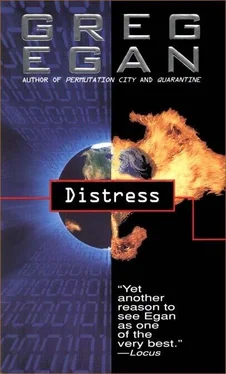

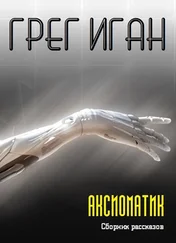

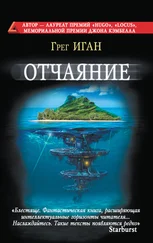
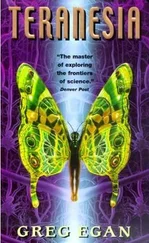
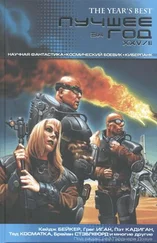

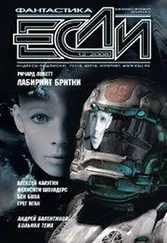
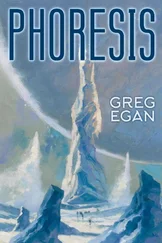
![Грег Иган - Рассказы [компиляция]](/books/419837/greg-igan-rasskazy-kompilyaciya-thumb.webp)
